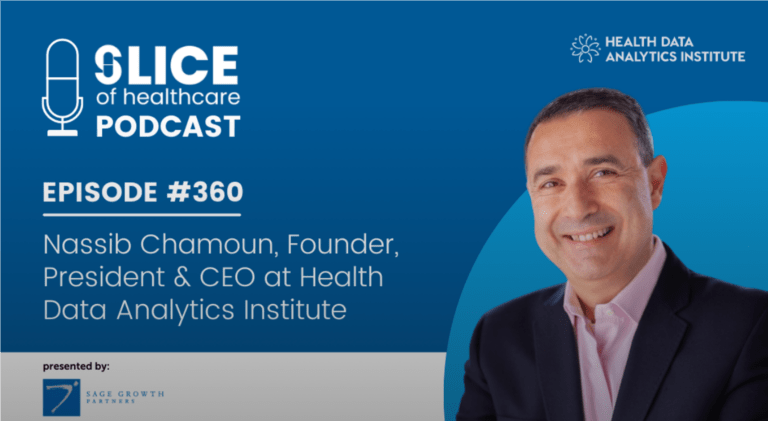Nassib Chamoun, HDAI’s founder, president and CEO, recently recorded a podcast with Slice of Healthcare’s Jared Taylor. They talked about Nassib’s background, AI’s role in healthcare and how HDAI’s analytics improve clinical and financial results. A link to the recording and a transcript of the conversation are below. The transcript of the conversation has been edited for length and clarity.
Jared Taylor: Nassib, tell us about your background.
Nassib Chamoun: I’m a healthcare entrepreneur. I’m a Lebanese immigrant, and I came to Boston about 40 years ago. I did my schooling at Northeastern University, did my graduate school at Boston University and the Harvard School of Public Health, and dropped out to start my first medical device company, which I ran for about 23 years, both as a private and public company.
I’ve been doing AI and machine learning and analytics in healthcare since then. About five years ago, I started the Health Data Analytics Institute. I took a short stint running a quantitative hedge fund, but I love healthcare a lot better.
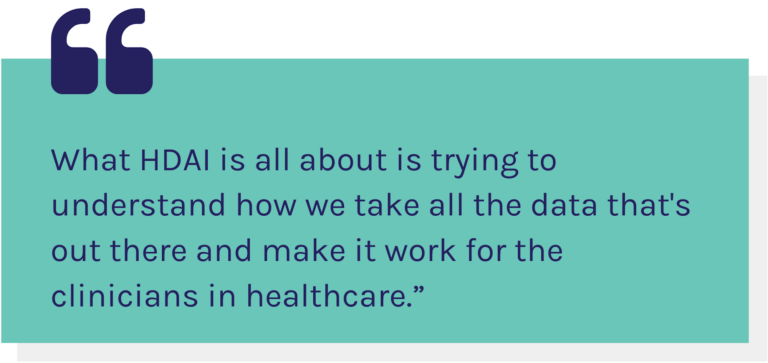
Jared Taylor: And you were utilizing AI before it was cool?
Nassib Chamoun: Absolutely. I’ve been focusing on it literally since computers were used to analyze healthcare data, and it’s been a blast since, and it keeps getting better.
Jared Taylor: Now everyone’s great uncle knows or has heard of AI.
Nassib Chamoun: Everybody’s talking about it today.
Jared Taylor: Give us an overview of what you’re working on today and what really excites you about the company.
Nassib Chamoun: What HDAI is all about is trying to understand how we take all the data that’s out there and make it work for the clinicians in healthcare.
A lot of work has gone into collecting the data, warehousing the data, not unlike what OpenAI has done with what’s on the web. There’s tons of data out there. How do you organize it? How do you curate it? How do you make this information work for those who need it when they need it during the care of their patients?
HDAI is an enabling platform and technology that allows clinicians across the continuum of care to access the information they need, in a format that’s easy to digest, that’s very efficient, that gets them to focus on the patients who need more of their attention.
So, we’re not trying to solve a clinical problem. I think it’s more operational. You have too many patients, too much data, too little time. How do you get to what you need to do to do your job as a clinician, whether you’re a nurse, a doctor, a care coordinator, or even an administrator trying to understand what’s going on within your organization?
So, we bring all those pieces together and we help organizations first understand what’s working and what’s not working for them by using AI to analyze all the dimensions of cost, outcomes, and utilization. And then we use those same models and help them deploy them through our technology platform at the point of care so they can start to move the needle and change how they do things. That’s the big picture.
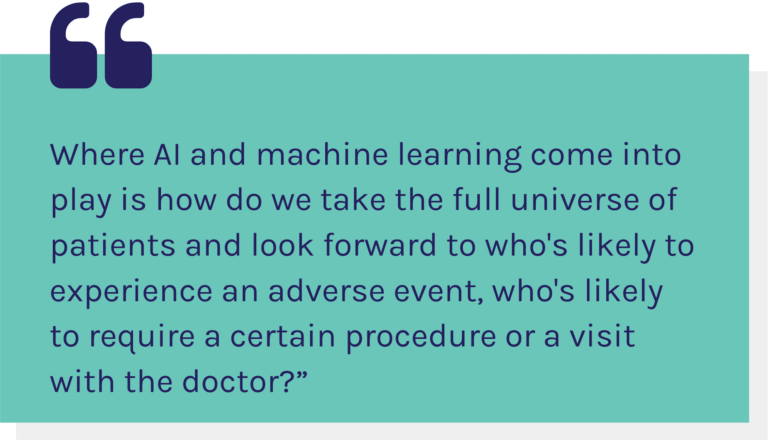
Jared Taylor: Where do you see AI’s role continuing to evolve, in your particular business but also in healthcare more broadly?
Nassib Chamoun: I think it will be an evolution, and today I’d say the most critical and pressing role is how to operationalize the data we have and make it deliver the kind of information that helps clinicians target the patients that need their attention, helps administrators understand where the information can help them optimize their efficiency, and helps patients understand the risks they have and the kind of care they should seek.
Ultimately, there is a transition of AI doing more, but there’s so much to do right now that hasn’t been done. If you look at healthcare, we’re way behind any industry in bringing this kind of capability to the day-to-day care management of patients and how we can make their lives better and how we can make their outcomes better through this technology.
Jared Taylor: It will be interesting to see how things continue to progress with AI in healthcare. When it comes to accountable care organizations [ACOs], using analytics to improve clinical and financial fronts, what are some of the best ways for them to do that? What are some suggestions on how they should be using analytics?
Nassib Chamoun: For accountable care organizations today, a lot of the analytics they do are top-down analytics. They take a group of patients and say, “So many of them went into the emergency room or had an unplanned admission or had a complication of some sort or went into a skilled nursing facility.” To manage this population, they tend to break them into buckets based on chronic conditions – – segmentation through utilization. You look at the past, you see what went on with patients, and you put them in these big buckets and start to focus on them.
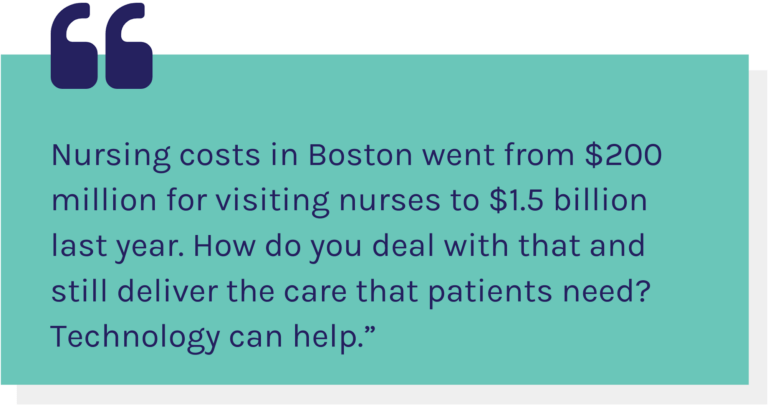
The problem with that is these segments are intertwined. There are too many of them, and the intersections are complicated. Before you know it, you either create big buckets that consume a lot of resources where a few patients in a bucket may need your attention, or very small buckets that focus on very high-risk patients, but you miss a lot of other people.
Where AI and machine learning come into play is how do we take the full universe of patients and look forward to who’s likely to experience an adverse event, who’s likely to require a certain procedure or a visit with the doctor? These models look at all the pieces that happened in the past and the likelihood of something happening in the future. They guide better targeting and focus on the areas you’re trying to address without having to manually figure it out.
Today, it’s been advanced dramatically through these types of AI and machine learning algorithms to make it much more focused and targeted. It allows you to really manage your full population. I call it the machine behind the scenes. It’s going through the records of your patients all the time, and understanding what happened to them, what new conditions have emerged, and, more important, what’s likely to emerge in the future. And putting them in front of the clinicians in a way that allows them to apply their skills and expertise to manage those patients more effectively.
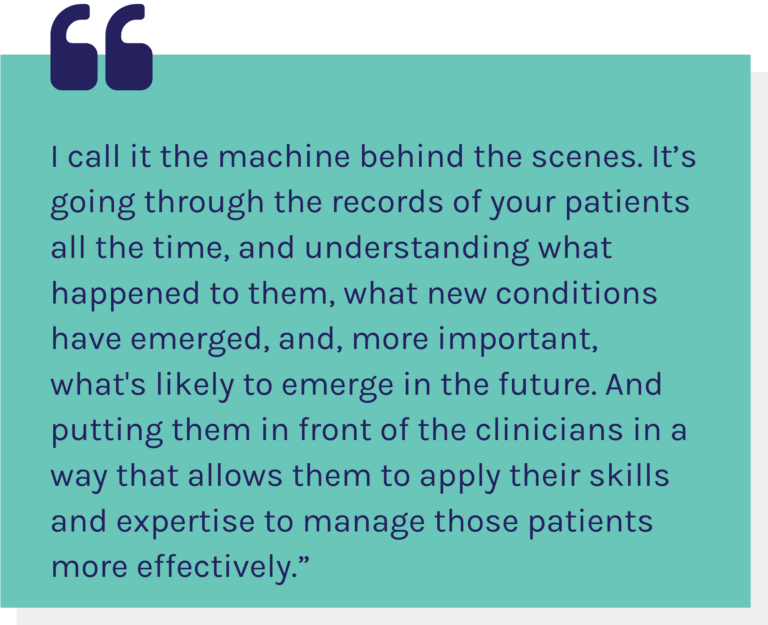
The goal is not to play doctor. The goal is to make the clinicians, the nurses, a lot more efficient and targeted in what they do because resources are limited, patients are getting older and sicker, and they require more attention. How do you distribute that in the world today?
I was at a meeting yesterday at one of the major medical centers, where I serve on the board, and they said nursing costs in Boston went from $200 million for visiting nurses to $1.5 billion last year. How do you deal with that and still deliver the care that patients need? Technology can help.
Jared Taylor: That’s really interesting. What gaps or challenges still exist in the analytics field that you would like to see us get past in the near future?
Nassib Chamoun: I’ll start with one of my favorite quotes, from the head of analytics at a major health system that we work closely with. He said, “We do the right things for our patients, but we do them randomly.” What he meant by that is clinicians, health systems, and ACOs are all committed to doing the best for their patients. The question is, are they able to identify all the patients who require that extra level of attention and give it to them? Or is the care they’re delivering kind of diffuse across the full population?
Today, if you look at the data and the patients who have adverse events, complications, or need certain labs, testing, or screening, and you look at the likelihood of them needing it or the risk of them having that event relative to the resources allocated to those patients, it’s relatively flat. Which says that in order to figure things out, we have to touch a lot of people and try to find our way through it.
AI can really do a lot of the legwork behind the scenes and try to address, for example, who are the patients who should be screened by a certain test and how frequently that should happen. It doesn’t mean that the clinician should do it, but can I surface to the top, the 10 patients you look at and the two or three that you end up proceeding with the testing. Who’s likely to end up in the emergency room? Maybe we should call them and bring them in for some periodic checks. You’re not going to eliminate all these events, but you can focus on the patients who need the care versus patients who want the care.
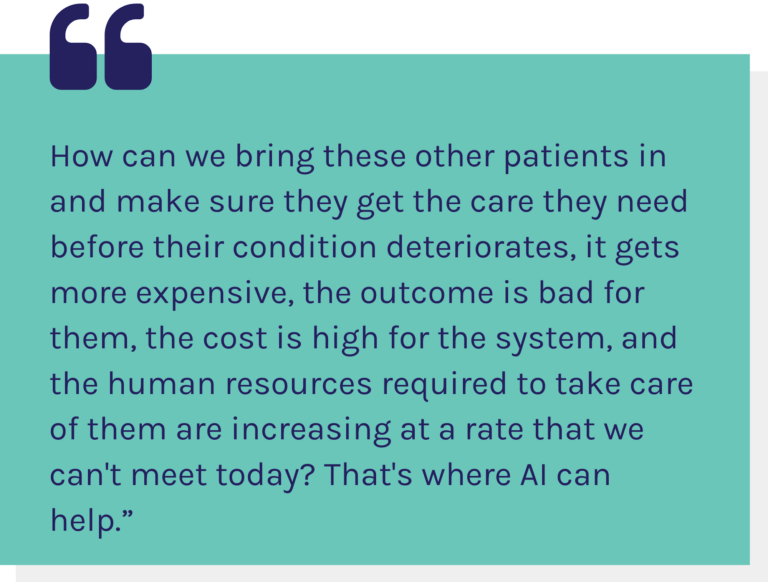
A lot of us fall into the “worried well” category and we go to the doctor just as a safety check. But many don’t, and many are percolating out there, progressing towards a bad outcome, and they go unnoticed because doctors’ offices are answering the phone from people like you and me who call and go in to see them routinely.
How can we bring these other patients in and make sure they get the care they need before their condition deteriorates, it gets more expensive, the outcome is bad for them, the cost is high for the system, and the human resources required to take care of them are increasing at a rate that we can’t meet today? That’s where AI can help.
Jared Taylor: What’s next for you and the company that you’re really excited about?
Nassib Chamoun: I think there are a lot of myths about AI out there. People think it’s either a silver bullet or something that’s really bad that’s going to disadvantage patients and society. I’m very optimistic about what we can do to help dispel these myths and bring reality to the table. We think if we had more modest expectations of what AI and machine learning can do for us, everybody’s going to make enormous progress forward.
So, it’s not about the models, it’s not about AI per se. It’s about how do we take AI and integrate it into the care pathways and the workflows that clinicians have in place today? How do we change the paradigm of operating in the healthcare system with the assistance of these tools?
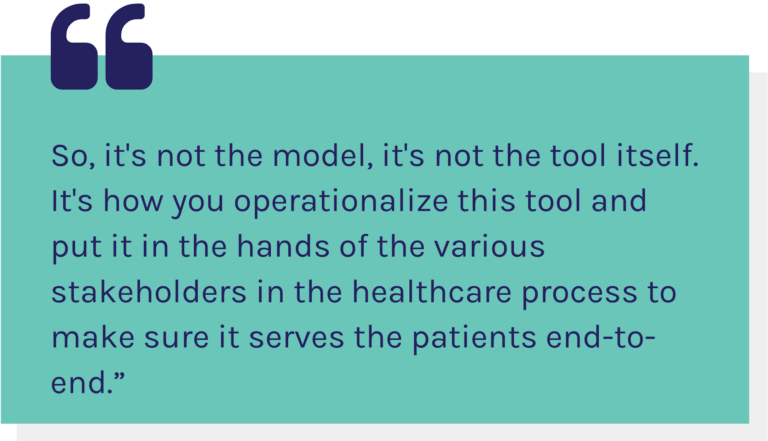
A lot of the resources that HDAI is spending and investing in today are less about the AI itself and more about: how do I merge this information with everything else that clinicians are doing in a way to improve their workflows, their pathways, and ultimately the process by which they care for patients? Succeeding with that and helping everybody transition to that is ultimately what’s going to create and drive value.
So, it’s not the model, it’s not the tool itself. It’s how you operationalize this tool and put it in the hands of the various stakeholders in the healthcare process to make sure it serves the patients end-to-end. It’s not just about the doctor. It’s the patient, it’s the nurse that takes your information, it’s ultimately the care coordinator that’s organizing what’s going to happen. It’s those that are in a hospital caring for that patient during and after they get discharged from the hospital. How can we give them the thread of information that’s consistent, so everybody’s taking the same actions and ultimately making a difference for that patient?
Jared Taylor: Well, I want to thank you once again for joining me on the podcast today.

